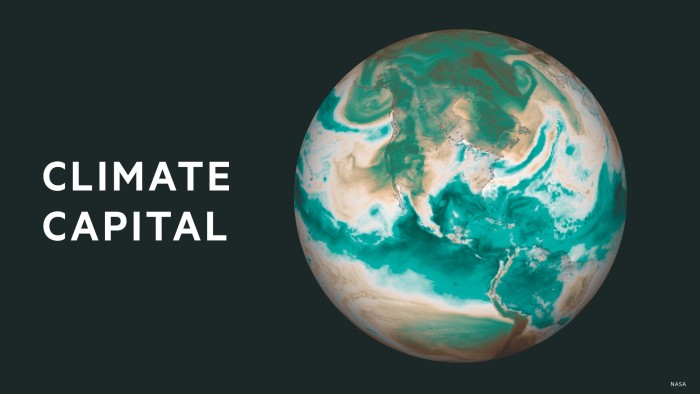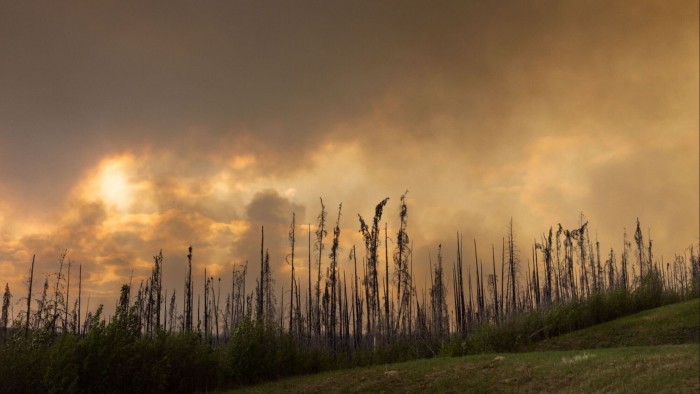Stay informed with free updates
Simply sign up to the Climate change myFT Digest — delivered directly to your inbox.
“Zombie fires” smouldering under the snowpack in Canada since last winter have ignited as the weather heats up, contributing to an intense start to the wildfire season in large parts of Canada, scientists and fire experts say.
Scientists are studying the rise of the phenomenon, also known as overwinter or holdover fires, where the soil catches alight during summer and burns extremely slowly underground during the subsequent winter.
The rich organic peat and moss that is common in the boreal region helps keep the flameless blaze alive even under layers of snow. The snowpack instead insulated the fire, said Thomas Theurer, research fellow and a fire expert at the University of Aberdeen.
“As conditions return to warm and dry conditions of the summer, that burning will continue to propagate and then reach the surface again, potentially re-emerging as a flaming wildfire,” he said.
Fires that spread underground are harder to fight, because they are more difficult to detect and access.
The British Columbia Wildfire Service said by midweek there were 49 active wildfires in the province which had overwintered from the 2024 fire season, all located in the northeastern region near Fort Nelson.
“Holdover fires in northern British Columbia are one of many factors contributing to the current fire situation in the province — if weather conditions were cooler and wetter, they would not be able to become active again,” said Jen Baron, a fire ecologist at the University of British Columbia.
Evacuation orders were issued for areas of BC this week, while Saskatchewan, Manitoba and Ontario are also experiencing blazes fuelled by a lack of rain and warmer temperatures.
Smoke from the fires reached as far as Europe and the US, spreading from New York to the Gulf coast. Europe’s earth monitoring service Copernicus said additional plumes are expected in coming days.
It was the backdrop to a first ministers’ meeting held in Saskatoon by Canadian prime minister Mark Carney earlier in the week, where he acknowledged the firefighters and evacuees. About 5 per cent of Canada’s crude output was also threatened as key production sites in Alberta’s oil sands region closed.
Zombie fires are less understood than other types of pyrology, partially because they were previously uncommon. “If we go 60-100 years ago, they [zombie fires] would appear very infrequently. But now they’re all over the place,” said Sebastian Wieczorek, a professor at University College Cork.
A study earlier this year suggested an underground fire burning close to the surface may be extinguished by moisture from subsequent snow melt. But fire burning deep down in the soil might not be affected by the moisture, which could be absorbed by the top soils or evaporate due to the heat from the smouldering matter below, leaving the subterranean burn to continue.
Fires are a natural part of the boreal forest life cycle, but global warming is exacerbating the dry conditions behind wildfires across the northern hemisphere.
“Climate change plays a role because the summer is warmer and allows for more fire to move into the soil, which then finds protection from the snow, but [the fires] come back even sooner when spring is warmer,” said Guillermo Rein, professor of fire science at Imperial College London.
Peatlands are vital in storing carbon dioxide, holding more carbon than all the world’s forests combined. Blazes in such areas can release this stored carbon back into the atmosphere, further contributing to climate change.
Modelling from Wieczorek and his colleagues has suggested that zombie fires could occur when a rapid rise in surface temperatures causes the peat to suddenly heat by activating microbes, reaching smouldering temperatures underground without any spark or other external ignition.
“People are afraid of [zombie fires] and they are really scratching their heads about how you put them out. It really is underground,” said Wieczorek. “This is what is scary about them.”
Additional reporting by Ilya Gridneff in Toronto
Climate Capital

Where climate change meets business, markets and politics. Explore the FT’s coverage here.
Are you curious about the FT’s environmental sustainability commitments? Find out more about our science-based targets here
